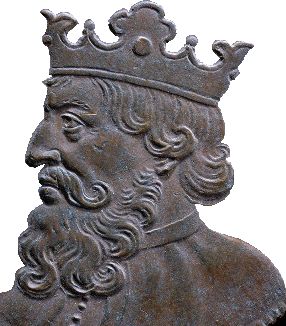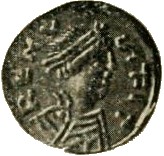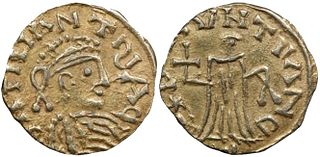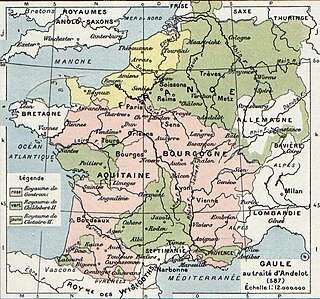
Year 567 (DLXVII) was a common year starting on Saturday of the Julian calendar. The denomination 567 for this year has been used since the early medieval period, when the Anno Domini calendar era became the prevalent method in Europe for naming years.

Year 613 (DCXIII) was a common year starting on Monday of the Julian calendar. The denomination 613 for this year has been used since the early medieval period, when the Anno Domini calendar era became the prevalent method in Europe for naming years.

Year 575 (DLXXV) was a common year starting on Tuesday of the Julian calendar. The denomination 575 for this year has been used since the early medieval period, when the Anno Domini calendar era became the prevalent method in Europe for naming years.

Gregory of Tours was a Gallo-Roman historian and Bishop of Tours during the Merovingian period and is known as the "father of French history." He was a prelate in the Merovingian kingdom, encompassing Gaul's historic region.

Austrasia was a territory which formed the north-eastern section of the Kingdom of the Franks from the 6th to 8th centuries, ruled by the Frankish Merovingian and Carolingian dynasties during the Early Middle Ages. It was centred on the Meuse, Middle Rhine, and the Moselle rivers, and was the original territory of the Franks, including both the so-called Salian Franks and Ripuarian Franks, which Clovis I, King of the Franks (481–511) conquered after first taking control of the bordering part of Roman Gaul, which is sometimes described in this period as Neustria.

Chlothar II, sometime called "the Young", was king of the Franks, ruling Neustria (584-629), Burgundy (613-629) and Austrasia (613-623).

Chilperic I was the king of Neustria from 561 to his death. He was one of the sons of the Frankish king Clotaire I and Queen Aregund.

Childebert II (c.570–596) was the Merovingian king of Austrasia from 575 until his death in March 596, as the only son of Sigebert I and Brunhilda of Austrasia; and the king of Burgundy from 592 to his death, as the adopted son of his uncle Guntram.

The Kingdom of the Franks, also known as the Frankish Kingdom, the Frankish Empire or Francia, was the largest post-Roman barbarian kingdom in Western Europe. It was ruled by the Frankish Merovingian and Carolingian dynasties during the Early Middle Ages. Francia was among the last surviving Germanic kingdoms from the Migration Period era.

Sigebert I was a Frankish king of Austrasia from the death of his father in 561 to his own death. He was the third surviving son out of four of Clotaire I and Ingund. His reign found him mostly occupied with a successful civil war against his half-brother, Chilperic.

Galswintha (540–568) was a queen consort of Neustria. She was the daughter of Athanagild, Visigothic king of Hispania, and Goiswintha. Galswintha was the sister of Brunhilda, Queen of Austrasia; and the wife of Chilperic I, the Merovingian king of Neustria. Galswintha was likely murdered at the urging of Chilperic's former concubine Fredegund, instigating a 40-year civil war within the Merovingian kingdom.
Fredegund or Fredegunda was the queen consort of Chilperic I, the Merovingian Frankish king of Soissons. Fredegund served as regent during the minority of her son Chlothar II from 584 until 597.

Saint Gontrand, also called Gontran, Gontram, Guntram, Gunthram, Gunthchramn, and Guntramnus, was the king of the Kingdom of Orléans from AD 561 to AD 592. He was the third-eldest and second-eldest-surviving son of Chlothar I and Ingunda. On his father's death in 561, he became king of a fourth of the Kingdom of the Franks, and made his capital at Orléans. The name "Gontrand" denotes "War Raven".

Sigebert III was the Merovingian king of Austrasia from 633 to his death around 656. He was described as the first Merovingian roi fainéant —do-nothing king—, in effect the mayor of the palace ruling the kingdom throughout his reign. However he lived a pious Christian life and was later sanctified, being remembered as Saint Sigebert of Austrasia in the Roman Catholic Church and Eastern Orthodox Church.
Brunhilda was queen consort of Austrasia, part of Francia, by marriage to the Merovingian king Sigebert I of Austrasia, and regent for her son, grandson and great-grandson.

Theuderic II (587–613), king of Burgundy (595–613) and Austrasia (612–613), was the second son of Childebert II. At his father's death in 595, he received Guntram's kingdom of Burgundy, with its capital at Orléans, while his elder brother, Theudebert II, received their father's kingdom of Austrasia, with its capital at Metz. He also received the lordship of the cities (civitates) of Toulouse, Agen, Nantes, Angers, Saintes, Angoulême, Périgueux, Blois, Chartres, and Le Mans. During his minority, and later, he reigned under the guidance of his grandmother Brunhilda, evicted from Austrasia by his brother Theudebert II.

The Treaty of Andelot was signed at Andelot-Blancheville in 587 between King Guntram of Burgundy and Queen Brunhilda of Austrasia. Based on the terms of the accord, Brunhilda agreed that Guntram adopt her son Childebert II as his successor and ally himself with Childebert against the revolted leudes. Gregory of Tours wrote in his Historia Francorum that in the thirteenth year of Childebert, he went on an embassy for the king from Metz to Chalon to meet Guntram, who alleged that prior promises were being broken, especially concerning the division of Senlis. Significantly to Gregory, the treaty brought about the cession of Tours by Guntram to Childebert. An agreement was provided in writing and Gregory preserves the text of the treaty in his history.
Grasulf I was a nephew of Alboin, the first Lombard King of Italy, and brother of Gisulf, the first Duke of Friuli, whom he succeeded as duke sometime after 575.
Ingunde, Ingund, Ingundis or Ingunda, was the eldest child of Sigebert I, king of Austrasia, and his wife Brunhilda, daughter of King Athanagild of the Visigoths. She married Hermenegild and became the first Catholic queen of the Visigoths.
Chlodosinda was a Frankish princess, the daughter of King Sigebert I and Queen Brunhilda.